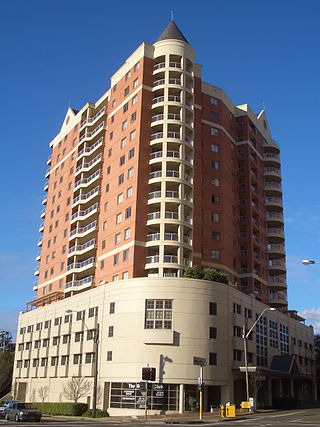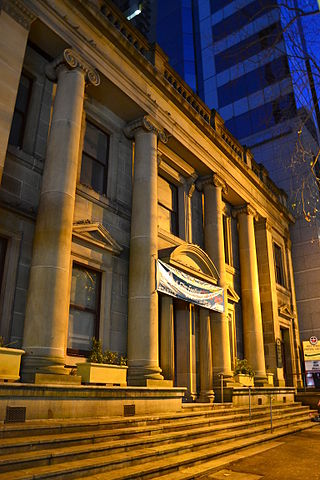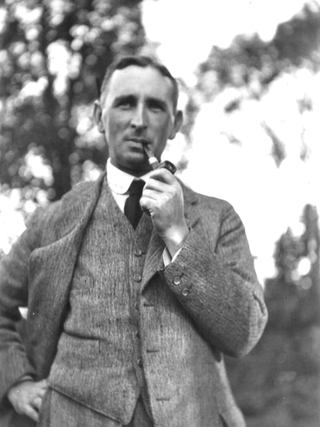
Homebush is a suburb in the Inner West of Sydney in the state of New South Wales, Australia. It is located 12 kilometres west of the Sydney central business district, in the local government area of the Municipality of Strathfield.

The Municipality of Strathfield is a local government area in the Inner West of Sydney, in the state of New South Wales, Australia.

Strathfield is a suburb in the Inner West of Sydney, in the state of New South Wales, Australia. It is located 12 kilometres west of the Sydney central business district and is the administrative centre of the Municipality of Strathfield. A small section of the suburb north of the railway line lies within the City of Canada Bay, while the area east of The Boulevard lies within the Municipality of Burwood. North Strathfield and Strathfield South are separate suburbs to the north and south, respectively.

Strathfield railway station is a heritage-listed railway station located on the Main Suburban line in the Sydney suburb of Strathfield in the Municipality of Strathfield local government area of New South Wales, Australia. The station is served by Sydney Trains T1 North Shore & Western Line, T9 Northern Line and T2 Inner West & Leppington Line suburban services as well as NSW TrainLink Intercity and regional services. The station is located on the Main Northern and Main Western railway lines, forming a major junction for regional and suburban rail services. The station and associated infrastructure was added to the New South Wales State Heritage Register on 2 April 1999.

North Strathfield is a suburb in the inner-west of Sydney, in the state of New South Wales, Australia. North Strathfield is located 15 kilometres west of the Sydney central business district, in the local government area of the City of Canada Bay. Strathfield and Strathfield South are separate suburbs, to the south.

Flemington, officially gazetted as "Homebush West" since 1992, is a suburb in the Inner West of Sydney, in the state of New South Wales, Australia. Flemington is located 13 kilometres west of the Sydney central business district, in the local government area of the Municipality of Strathfield, with a small unpopulated area in Cumberland Council.

Carlyle Greenwell was an Australian architect whose houses, designed in the first half of the 20th century, are often heritage-listed. He was also a philanthropist who made bequests to the University of Sydney funding research in Anthropology and Archaeology.
Henry "Harry" Ebenezer Budden was a Sulman Award winning Australian architect active in the first 40 years of the 20th century. His work encompassed the styles of the Federation Arts and Crafts and Bungalow through to the Inter-War Stripped Classical and Art Deco. He was a leader of his profession and in the wider community, serving as the first Australian War Chest Commissioner during World War I.

The Pitt Street Uniting Church is a heritage-listed Uniting church building located at 264 Pitt Street in the Sydney central business district, Australia. Founded in 1833, the congregation was the original church of Congregationalism in New South Wales. The church building was designed by John Bibb and built from 1841 to 1846. It is also known as Pitt Street Congregational Church. The property is owned by The Uniting Church in Australia and was added to the New South Wales State Heritage Register on 2 April 1999.
Kent Budden & Greenwell was an Australian architectural practice working in Sydney from 1913 until 1919. The partners were Harry Kent, Henry Budden and Carlyle Greenwell.

Alfred Gambier Newman was an Australian architect active in the first 20 years of the 20th century. He designed significant work for both the Methodist Church and the Newman and Vickery families.
Stanley Noble Rickard was a New Britain-born Australian architect active in Sydney and Los Angeles in the first half of the 20th century. His work in the Federation Bungalow style is listed on the NSW State Heritage Register.

Thomas Pollard Sampson was a Tasmanian-born Australian architect active in New South Wales during the first forty years of the 20th century. His work encompassed the styles of the Federation Arts and Crafts and Bungalow through to the Inter-War Styles. In 1912 he designed an octagonal roofed stadium at Rushcutters Bay that seated up to 12,000 spectators. At the time, the Sydney Stadium was said to be "the largest roofed-in structure in the world." In the 1920s and 1930s, as a golfer and member of Concord Golf Club and Pennant Hills Golf Club, he designed the clubhouses at both courses. The buildings of both these well known Sydney clubs are still in use in 2023.

The Trinity Uniting Church is a heritage-listed Uniting church located at 62 The Boulevarde, in the Sydney suburb of Strathfield in the Municipality of Burwood local government area of New South Wales, Australia. It was designed by George Sydney Jones & Harry Thompson and built from 1889 to 1890 by Thomas Hanley of Balmain. It is also known as Trinity Congregational Church. The property is owned by the Uniting Church in Australia. It was added to the New South Wales State Heritage Register on 19 September 2003.

The Mariners' Church is a heritage-listed former church and seamen's mission and now nightclub, bar and restaurant located at 98–100 George Street in the inner city Sydney suburb of The Rocks in the City of Sydney local government area of New South Wales, Australia. It was designed in various stages by J. Bibb, H. C. Kent and Kent & Massie and was built from 1856 to 1859. It is also known as Mission to Seamen; Rawson Institute for Seamen & Mariners' Church; Craft Centre. The property is owned by Sydney Harbour Foreshore Authority, an agency of the Government of New South Wales. It was added to the New South Wales State Heritage Register on 10 May 2002. The building was previously a cafe, place of worship and craft centre.

Mount St Mary Campus of the Australian Catholic University is a major campus of the Australian Catholic University, located in Strathfield, Municipality of Strathfield, Sydney, New South Wales, Australia.
William Harry Jefferis was an Australian-born architect who practiced principally in Perth and later in Albany in Western Australia.

Joseph Alexander Kethel was an Australian architect notable for the many substantial private residences and pastoral homesteads he designed throughout New South Wales and the striking theatres, office buildings and Presbyterian Churches he designed in Sydney.
Alan Porter Nangle was an Australian architect active during the mid-20th century. He worked on many independent school campuses when he become a partner in architectural firms associated with his mentor Henry Budden.
Herbert Osborn Dennis was a Victorian-born Australian architect who largely practiced in Sydney and is known for his early domestic designs and for his later substantial inner city industrial buildings showcasing early modernism.





















